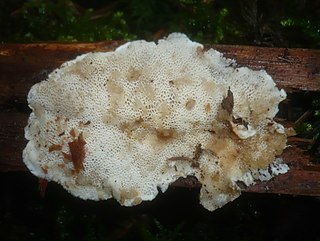
The Tremellomycetes are a class of dimorphic fungi in the Agaricomycotina. Some species have gelatinous basidiocarps or (microscopically) a sacculate parenthesome. There are six orders, 17 families, and 39 genera in the Tremellomycetes. Tremellomycetes include yeasts, dimorphic taxa, and species that form complex fruiting bodies. Tremellomycetes include some fungi that are human and animal pathogens in the genera Cryptococcus, Naganishia, Papiliotrema, and Trichosporon and some fungi that are cultivated for food in the genera Tremella and Naematelia.
The Cystofilobasidiales are an order of fungi in the class Tremellomycetes of the Basidiomycota. They usually exhibit a life phase of free-living yeasts. The order contains two families with seven genera and some 25 species.

The Tremellales are an order of fungi in the class Tremellomycetes. The order contains both teleomorphic and anamorphic species, most of the latter being yeasts. All teleomorphic species in the Tremellales are parasites of other fungi, though the yeast states are widespread and not restricted to hosts. Basidiocarps, when produced, are gelatinous.
The Cuniculitremaceae are a family of fungi in the order Tremellales. There are three genera in the family. Sterigmatosporidium polymorphum parasitizes other fungi growing in insect galleries in wood. It does not produce basidiocarps, but has septate basidia similar to those found in the genus Tremella. Most species are known only from their yeast states.
The Cystofilobasidiaceae are a family of fungi in the order Cystofilobasidiales. Phylogenetic analyses shows that this family is clearly distinct from other yeast-like families of the Tremellomycetes. The family currently contains the single genus Cystofilobasidium. Additional genera previously referred to the Cystofilobasidiaceae are now placed in the Mrakiaceae.
Bulleribasidium is a genus of fungi in the family Bulleribasidiaceae. The genus currently contains some eleven species. The type species is a parasite of other fungi, its teleomorph having septate basidia and haustorial cells on its hyphae that connect to the host hyphae. Most species are, however, only known from their yeast states.
Kwoniella is a genus of fungi in the family Cryptococcaceae. The genus originally contained the single species Kwoniella mangrovensis, found in the Florida Everglades and The Bahamas. Molecular research, based on cladistic analysis of DNA sequences, has however, now extended the genus to eleven species, most known only from their yeast states.
Papiliotrema is a genus of fungi in the family Rhynchogastremaceae. Filamentous states, where known, form septate basidia with haustorial cells indicating they are parasites of other fungi. Most species are currently known only from their yeast states. More than 20 species have been referred to Papiliotrema.

Phaeotremella is a genus of fungi in the family Phaeotremellaceae. All Phaeotremella species are parasites of other fungi and produce anamorphic yeast states. Basidiocarps, when produced, are gelatinous and are colloquially classed among the "jelly fungi". Fifteen or so species of Phaeotremella are currently recognized worldwide. Tremella sanguinea, shown to be a Phaeotremella species by DNA sequencing, is cultivated in China as an ingredient in traditional Chinese medicine.
Cystofilobasidium is a genus of fungi in the family Cystofilobasidiaceae. Species occur as yeasts, but produce filamentous sexual states that form dikaryote teliospores, from which the unicellular basidia are formed. The hyphae usually have dolipore septa without a parenthesome, and their cell walls contain xylose. The genus currently contains nine species worldwide.
Naganishia vishniacii is an extremophile fungus originally isolated as a yeast from soil samples in the dry valleys of Antarctica. The species grows at 4 degrees Celsius and below but not at 26 degrees Celsius and above. Visually it is characterized as a cream mass in culture. It is nonfermentative and assimilates glucose, maltose, melezitose, trehalose, and xylose. Molecular research, based on cladistic analysis of DNA sequences, shows that the species does not belong in the Cryptococcaceae.
The Bulleraceae are a family of fungi in the order Tremellales. The family currently contains five genera. Some species produce gelatinous basidiocarps and were formerly placed in the genus Tremella. Most, however, are only known from their yeast states.
Naganishia adeliensis is a species of fungus in the family Filobasidiaceae. It is currently only known from its yeast state, isolated from decaying algae in Antarctica.
Naganishia albidosimilis is a species of fungus in the family Filobasidiaceae. It is currently only known from its yeast state, isolated from soil in Antarctica.
Solicoccozyma is a genus of fungi in the family Piskurozymaceae. Species have only been isolated in their yeast states, several of which were formerly referred to the genus Cryptococcus, but can produce filamentous states with basidia in culture. Nine species have been described worldwide.
The Trichosporonaceae are a family of fungi in the order Trichosporonales. The family currently contains six genera. Species are not known to produce basidiocarps, but exist as yeasts or produce septate hyphae with arthroconidia. Several species are human pathogens.
The Tetragoniomycetaceae are a family of fungi in the order Trichosporonales. The family currently contains four genera. Several species are only known from their yeast states.

The Carcinomycetaceae are a family of fungi in the order Tremellales. The family currently contains a single genus. Some species produce filamentous sexual states with basidia and are parasites of other fungi. Some, however, are only known from their yeast states.

Phaffia is a genus of fungi in the order Cystofilobasidiales. The genus comprises orange-red yeasts that form basidia directly from yeast cells, lack hyphae throughout their life cycle, and produce astaxanthin, a carotenoid used as an additive in animal feed to enhance colour in shrimp, salmon, and poultry eggs and also as an antioxidant in dietary supplements.

Mrakia is a genus of fungi in the order Cystofilobasidiales. The genus comprises yeasts, some of which have a hyphal state forming teliospores from which basidia arise. Mrakia species are typically psychrophilic, many originally isolated from glaciers and frigid environments, and are capable of low-temperature fermentation, making them of potential interest in brewing and bioremediation.





